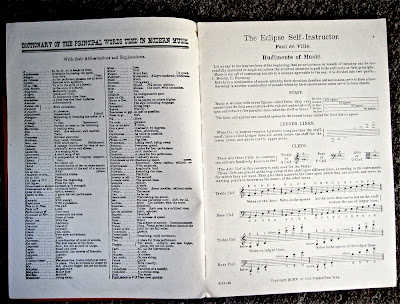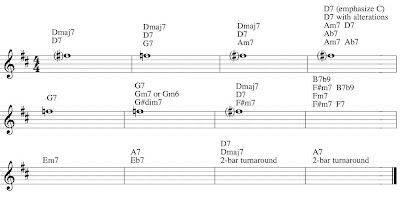This post will cover some of the devices (that is, practices, procedures, or tricks) that Charlie Parker often used in soloing over a 12-bar blues form. To illustrate how he implemented these devices, I’ll have a look at his solo on his classic tune “Billie’s Bounce.”
I initially thought of doing this post because it’s pretty much like a lesson I might give to a high school or adult sax student. At the lesson, we’ll first play through a transcription of a Parker solo, often a blues, and listen to the recording. I’ll then talk about the transcription, pointing out devices or approaches that seem noteworthy, trying to read Parker’s mind somewhat. Then the student and I do some blues improvising, and he or she can try to put those tricks into practice. This lesson gets students into analysis and applied theory, and gives them some familiarity with Bird’s style, which is of course the foundation of most jazz as it is played today.
I posted a
book review a couple of weeks ago in which I promised to analyze the “Billie’s Bounce” solo. However, I ran into a problem: Copyright restrictions prevent me from reproducing either the printed solo, or the recorded solo, for the reader’s reference. The recorded solo is easy to find - $.99 from iTunes. The transcription can be found in the
Charlie Parker Omnibook, and also in the Hal Leonard publication,
The Best of Charlie Parker.” These two versions differ in a few details.
Parker’s Characteristic Blues Devices
First, here is a measure-by-measure list of devices that Bird generally likes to use in soloing over a blues progression. I’ll assume here that we are in the key of D (the alto sax key for “Billie’s Bounce”):
m.1: Parker often (not always) uses the sound of a Dmaj7 chord here, as opposed to the more common D7. Occasionally he will use what we would now call a blues scale sound.
Note: If Parker implies a particular harmony by his note choice, this does not mean that the rest of the band will be using it - more on this below.
m.2: Traditionally, a G7 is often used here. Parker will sometimes ignore the G7 and continue the Dmaj7 through m2 or m3. If he uses an F#, he’s implying Dmaj7; if he uses an F, he’s implying G7.
Note: In the first 7 bars of a blues, Parker often includes notes from a guide tone line (voice leading line, or “thread”) that follows the F# in the tonic chord (third of Dmaj7 or D7) to the F in the subdominant chord (seventh of G7). See the chart at the end of this post.
Alternatively, Parker sometimes implies a ii V7 in m.2.
m.3: He generally uses notes that define Dmaj7 or D7. Occasionally he will imply Am7 here, to set up a D7 in bar 4.
m.4: Here Bird likes to bring out the sound of the note C, to make the tonic chord sound more like a V7 of IV, providing some push into the G7 (IV7) in bar 5. This is a traditional device going back almost to the beginning of the 12-bar blues form. Often Parker will enhance this effect by (1.) adding tension notes like #5, b9, or #9 to the D7, (2.) preceding the D7 with an outlined Am7 to set up a “ii V7” sound, (3.) implying an Ab7 in place of the D7 (tritone substitution), or (4.) some combination of the above. All of these devices have the effect of forcing the D7 to sound more like a dominant chord than a tonic, pushing towards a resolution to G7 in the next bar.
m.5: As mentioned above, he generally accentuates the F note in the G7. Also commonly heard here is the D “blues scale.”
m.6: Traditionally, one might use a Gm6 or G#dim7 chord here. Parker sometimes implies the Gm6 here by using a Bb note, even if the rhythm section is not playing this chord.
m.7: Parker generally prefers the sound of Dmaj7 here, rather than the traditional D7.
m.8: Lots of action here. Parker likes to imply B7b9, or / F#m7 B7b9 / (2 beats each), or / F#m7 Fm7 /, or Fm7. This would have been a “modern” sound in the early 1940s - something that traditional blues musicians wouldn’t play.
m.9: Em7 (ii) chord here, as expected.
m.10: A7 (V7), as expected, perhaps with tension notes.
mm.11-12: Sometimes a turnaround, sometimes a pause on a note that is not the tonic, to give an unresolved feeling.
Note on comping: Listening to Parker with various pianists, it seems to me that they tend to play simply, and stay out of his way. This makes sense; it leaves Bird the space to interpolate any reharmonizations he might decide to use at any given moment. For the “Billie’s Bounce” recording, the pianist was Dizzy Gillespie. Listening to Dizzy’s playing in m.8, he plays / F#m7 Fm7 / for the head and in all 4 solo choruses. Perhaps that was just his personal choice, or perhaps Bird asked him to do this. In either case, Parker knew to expect those chords. However, in his last two solo choruses Bird plays licks that definitely fit / F#m7 B7b9 / , contrary to Diz’s comping. The lesson to be learned here is that Parker felt free to play ideas that might contradict the expected harmony.
The Billie’s Bounce Solo
Below is my take on Parker’s “Billie’s Bounce” solo. It is from a recording session early in the period of his mature style (11/26/45), the first recording done under his own name. Download Parker’s version of this song from iTunes (it’s the one with duration 3:09), and get out your Omnibook!
I have divided the material into five 12-bar sections: the head (excluding the intro), and the four choruses of sax solo.
HEAD:
m.1: Most people today play the head as it reads in the Omnibook, but that’s not what I hear Parker playing. The fourth eighth note in m.1 should be E; the seventh note should be C. The transcription in “The Best of Charlie Parker” fixes the C, but not the E. The common (wrong) way might be an improvement.
m.8: This lick outlines the typical / F#m7 B7b9 / (or full measure B7b9), but also fits / F#m7 Fm7 /, which is what the pianist plays in m8 every time in this recording. The second eighth note in beat 2 should be a D.
m.9: The Omnibook shows a “turn” embellishing beat 3 of this measure, but Parker plays it without the turn. The Hal Leonard book corrects this.
mm.9-10: This lick outlines the chords / Em Em#7 / Em7 A7 /, incorporating a voice-leading line that goes E D# D C#. This is a way of embellishing ii V7 that Parker employed from time to time in various guises (see 4th chorus, mm.9-10).
1ST SOLO CHORUS:
mm.1-2: Bird must have liked this phrase as an opener; he used it 8 years later to open his solo on “Now’s the Time.”
Carl Woideck says it may derive from a Lester Young lick.
m.2: The opening melody line in mm.1-2 is similar to the head of “Ornithology.” That tune is often attributed to Parker, but was actually written by Benny Harris. According to Woideck, Harris got the opening lick from a Parker blues solo in a 1942 recording with Jay McShann’s band. The use of F# implies D7 or Dmaj7, not G7.
mm.5-6: Includes guide tone line, using the note F prominently.
m.7: The use of C# suggests Dmaj7, a favorite Bird device in this measure.
m.10: Another “Ornithology” lick.
2ND SOLO CHORUS:
m.1: “Blues scale” licks, not so common for Bird to use in m.1.
m.3: Note similarity to chorus 1, m.6.
mm.3-4: Brings out C natural by ending the phrase with it (see “devices” list).
m.5: Brings out F natural (guide tone).
mm.9-10: A favorite double-time lick over a ii V7 - often used by Bird, but only in this key, never any other. Sits nicely under the fingers on alto.
m.12: The eighth-note pickups outline the upcoming D chord. “Playing into the changes” (gearing solo notes to upcoming chord) is a favorite Bird device.
3RD SOLO CHORUS:
m.1: Use of note C rather than C# indicates that Parker is thinking D7 here, perhaps leading him to think of a G chord in the next measure.
m.2: Implies Gmaj9 with the notes F# and A; on beat 4, implies some sort of Gm chord with the note Bb.
m.5-6: Guide tone F for the G7.
m.7: Guide tone F# for the D7 (or Dmaj7).
m.8: Lick clearly outlines B7b9, although pianist continues to play / F#m7 Fm7 /. Note characteristic running of chord from 3 to b9.
m.10: b9 #9 lick on beat 4, another favorite device that uses chord extensions.
m.12: Pauses on E (fifth of A7), holds into next chorus.
4TH SOLO CHORUS:
mm.1-2: Guide tone F recognizes a G7 in m.2. The F also continues the held-note motif from chorus 3, m.12.
mm.5-6: Again, guide tone F for G7. Repeats lick from chorus 1, m.5; this was another in his bag of favorite licks.
m.7: Clear statement of Dmaj7, emphasizing note C#.
m.8: As in chorus 3, m.8, Bird outlines B7 while piano continues to play / F#m7 Fm7 /. Moral: If you are Charlie Parker, you can play what seems right to you without worrying about trivial points like precisely what the piano is laying down. If the idea has good continuity and is played with confidence, there will be no audible clash.
mm.9-10: This is another ii V7 elaboration, incorporating the notes / E D# / D C# /, the moving tones in an assumed underlying progression: / Em Em#7 / Em7 A7 /. See head, mm.9-10.
m.10: First three eighth notes are upper and lower neighboring tones bracketing a target chord tone, another favorite Parker device.
General Comments
Parker used a licks-based approach to improvisation, but was adept at altering the licks in his vocabulary, in many creative ways. His sense of harmonic placement was flexible; he often seemed to be mentally altering durations of chords, either hitting them early or prolonging them, or adding progressions that were not part of the accompaniment.
Parker was always melodic, always interesting. His notes were always there to make a statement, not because they strictly fit the original harmony.
I hope this analysis has been useful to somebody, somewhere. Sorry I couldn’t include a transcription of the solo. If you are a sax player, you should get a copy of the
Omnibook
anyway, if you don’t already have it.
The chart below shows the above mentioned “guide tone lines” for mm.1-7 as notes in the staff. Above the staff are chord options that Parker sometimes implies in his choice of notes. (Addendum: this chart should also show / Em7 A7 / as a possibility in bar 2.)



